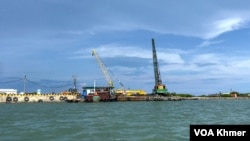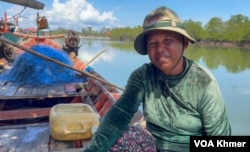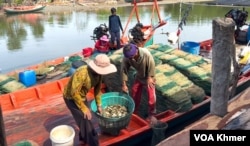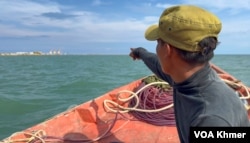The deep-sea area in Kampot province’s Kilo 12 village is where Bou Teap and other fisherfolk ply the waters for fish, crabs and shrimp.
But as port developments and other infrastructural projects multiply along the coast, Teap and others say the fishing culture has dramatically changed.
"They [developers] filled in – that wiped the seagrass and all the places where the fish lay eggs and have their nursery, so there was no place to fish,” she said, as she sat on a boat and removed garbage from her nets.
“[Now] we go deep into the sea to fish,” Teap added.
A rush of infrastructural growth along the coast – in addition to a surge of major private investments that have also filled large parts of Cambodia’s southern shoreline – have reshaped life for residents of Kilo 12 and elsewhere.
Beyond just a price tag, the cost of these works also includes major environmental impacts. While officials say the economic benefits of mass infrastructure development will more than make up for the ecological toll, those living at the forefront may struggle to realize these gains.
For fisherfolk such as Teap, a series of new shipping and maritime projects have already hurt traditional livelihoods drawn from the sea. In response, the fisherwoman said her peers are now working the waters in increasingly remote areas, or migrating elsewhere along the coast. Some borrow money from microfinance institutions to make a living.
"In the past, even if we did not go fishing for a month, we had money, we did not take loans from the bank," she said. "When the net broke or was lost, when a machine broke down, we had our own money to fix it. But after the fisheries decreased, we didn't have enough money – when the net is lost and the machine breaks down, we borrow money from others."
Such experiences highlight some of the tradeoffs of development.
The Kilo 12 village area is also the home of the Kampot Multi-Purpose Port – recently re-named from the Kampot International Port – which is owned and operated by the Kampot Port company. The port is connected to the Kampot Special Economic Zone, all of which is controlled by the tycoon Vinh Huor, who holds dozens of registered businesses across Cambodia.
Since about 2006, the company has been gradually filling its portion of the sea with sand to develop its facilities, which today represent one of just two modernized deep-sea ports in the country. In June, the company inaugurated a $140 million expansion planned as the first stage of a renovation scheme. The port has typically been used to import and temporarily store coal, which some neighboring residents complained has led to potentially hazardous coal dust blowing in the wind from the piles to settle on the roofs of their homes.
A phone number on the Ministry of Commerce business registration website listed for the port company connected to a person who said they were unaffiliated with it.
The coast of Kampot and the neighboring province of Kep is fertile territory for corals and seagrass, with extensive meadows of the latter that make critical habitat for a wide variety of marine life. A 2021 field study from non-governmental organization ActionAid Cambodia found some of the largest seagrass meadows around Kilo 12, with fields extending along the coast where other major developments are currently in the works.
The intensive work in Kampot is not an isolated affair. In the hopes of driving broad economic growth, Cambodia is in the midst of what its government hopes will be an infrastructure development boom.
Last year, the state unveiled a 174-project master plan that described $36.6 billion worth of projects. These included major upgrades of the deep-sea port at Sihanoukville, the country’s main international port. They also include the much-publicized construction of the Funan Techo Canal, a new shipping waterway that would link Phnom Penh to the Gulf of Thailand near the country’s existing ports. Besides the projects listed in the plan, developers recently finished a new tourism port also in Kampot that was built on land donated by Vinh Huor and with backing from the Asia Development Bank.
Conservationists contacted by a reporter declined to comment on the coastal developments or the canal, citing the political sensitivity of these projects.
Matthew Owen, project development executive at Ben Line Agencies and vice-chairman of the Transport and Logistics Committee of the European Chamber of Commerce in Cambodia, said expansion of the country’s ports will help lift the economy as a whole.
“Boosting the capacity of Cambodia to accept larger vessels increases trade with neighbors and foreign countries,” Owen said in a message. “This will help to bolster Cambodia's agricultural exports, increasing employment and economic trade with the world, making Cambodia a player on the major stage.”
At the inauguration ceremony for the Kampot Multipurpose Port’s expansion, which was completed on June 6, Prime Minister Hun Manet stated the facility is the first port in Cambodia to meet international standards.
"This port will contribute to becoming a new major artery for Cambodian maritime transport and upgrade to increase trade activities and exchange of goods, as well as help promote economic growth in Kampot as well as the socio-economic development of Cambodia,” said Hun Manet, adding the port will contribute to both local and more widespread job opportunities.
While these improvement projects move in the background, in 2022, a different group known as the Kampot Logistics and Port company has also been filling part of the Kampot coast in hopes of constructing a new $1.5 billion port.
Though ostensibly led by businessmen Ly Yim and Meas Thom, the company’s registered address is a private residence in Phnom Penh also used by Papa Petroleum and other companies linked to the the U.S.-sanctioned timber tycoon Try Pheap. That same property had also been the registered address for a now-dissolved organization known as the Kampot Multi-Purpose Port company, which had the senator’s son Try Daphors listed as its chairman.
It’s unclear if this company is connected to Vinh Huor’s port project, which now has the same name. In his inaugural address for that operational port, Hun Manet said he’d changed its name with an official sub-decree.
Phone calls to numbers for the company listed on its website went unanswered, as were others made to a number listed for Meas Thom on the Commerce Ministry website. Emails sent to the company by VOA also received no response.
Back at Kilo 12 village, business at the expanded international port is running as planned.
Roth Vutha, a fisherman living in Kilo 12 village, said some fishermen got jobs from the port, while others continued to fish in remote areas away from the coastline. Vutha said he was a truck driver at the port, earning between $200-250. Before the port development disrupted fishing in local waters, Vutha said he averaged $500-600 per month with his catch.
"In the past, there was no port and we would easily make a living from fishing,” he said. “[After] the port came in, there was not much area to do fishing, it was completely demolished. Anyway, if we work on a salary, it is not enough, it’s difficult. The salary from the port jobs is low, but if the salary was high, it would be OK."
To supplement his income and support his family, Vutha said he still fished when he wasn’t working.
Government officials and provincial authorities did not respond to VOA inquiries in detail about the impact on fishermen and did not provide any environmental impact assessment reports for the Kampot Multipurpose Port.
Kampot provincial administration spokesman Khun Usaphea directed questions to deputy governor Ung Chhay, who did not respond.
Khvay Atiya, a spokesman for the Ministry of Environment, told VOA Khmer briefly that he would look into the matter.
However, a spokesman for the Ministry of Public Works and Transport told VOA in a message that the Kampot Multipurpose Port, as well as the special economic zone, would have factories that could provide more jobs for local people. Spokesman Phorn Rim said about 200 people living in the area were currently working for the port company.
"Some fishermen who are strong, not too old, they came to work with the port company, causing their lives to be stable,” he wrote.
When asked about the neighbors’ health concerns about coal dust, Rim was dismissive.
"The company has been careful to protect [against] this issue, there is protection during transport and so on,” he commented.
Out Latin, project coordinator for the advocacy group Cambodian Youth Network, told VOA that developments that help the economy can be positive, but that any new plans should consider impacts on people and the environment.
"In order to prevent people from being [treated] unfairly by development and to reduce the destruction of biodiversity or damage to local ecosystems, environmental impact assessments [should] be guaranteed," he said.
"With the participation of local people, development partners such as companies and the royal government should work together to show transparency and efficiency of projects."
This story was supported by Internews’ Earth Journalism Network through the Strengthening Transparency in Infrastructure Development Through Environmental Reporting in Southeast Asia project.









